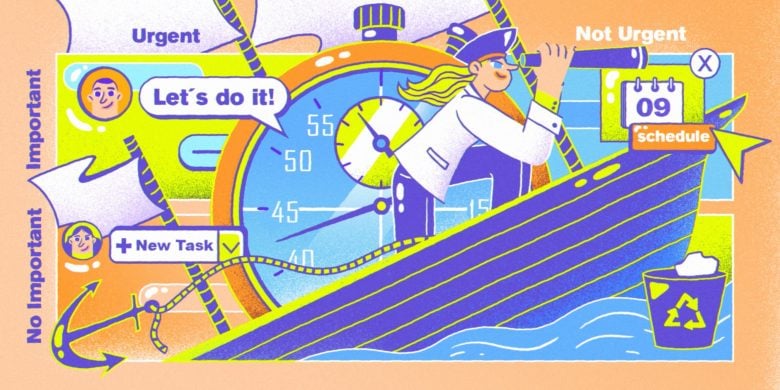Would you believe us if we told you there is a direct connection between employee satisfaction and productivity? Well, it’s time to start believing. Compelling research from MIT confirms this link between worker engagement and productivity.
That means employee satisfaction can directly increase your bottom line. It’s a bold claim to make, but don’t worry. We’ll touch on this in more detail later and back it up with statistics.
The key is to quantify employee satisfaction. That means finding the right tools to measure employee satisfaction and leveraging those insights to implement targeted improvements. This creates a positive work culture that boosts morale and engagement.
Today, we will explain why employee satisfaction directly impacts workplace productivity and how you can quantify and achieve the elusive goal of a satisfied team. But first, let’s establish a common understanding of employee satisfaction.
Boost your team’s efficiency with Hubstaff's productivity tools
What is employee satisfaction?
Employee satisfaction refers to the overall feelings employees experience related to their work. It encompasses different factors, including work environment, relationships with co-workers and managers, compensation, benefits, and opportunities for professional growth.
The importance of employee satisfaction
First, let’s be clear that employee satisfaction would still be a critical goal to work towards, even if it didn’t impact productivity. There is a win-win element to employee satisfaction that studies and research have found where businesses benefit from their employee’s happiness.
Still, employee satisfaction is essential because the alternative, burnout, overworking, and dissatisfaction at work are terrible for employees’ physical health and mental well-being.
Beyond the altruistic goal of improving people’s lives, there are some significant benefits of improving employee satisfaction. Here are the broad strokes of what employee satisfaction can do for your business:
- Satisfied employees tend to be more engaged, productive, and committed to company goals.
- High satisfaction levels contribute to lower turnover rates, combatting the high cost of hiring.
- Happy employees are more likely to provide better customer service, positively impacting the overall success and reputation of the organization.
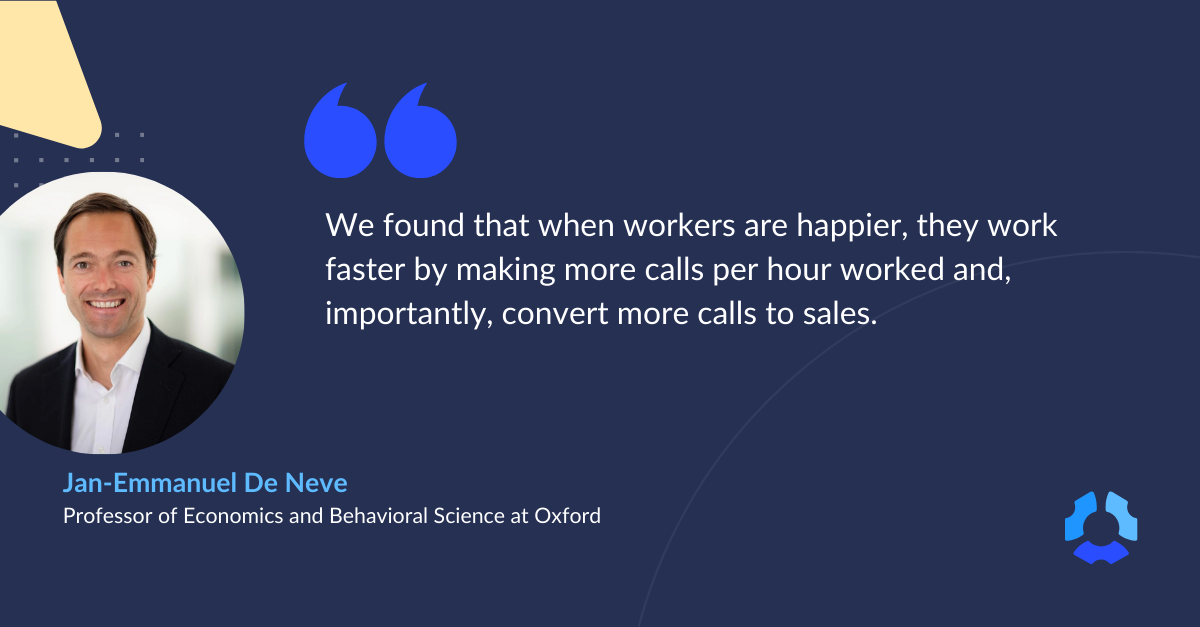
The compelling connection between job satisfaction and productivity
Employee satisfaction’s influence extends beyond individual happiness to impact an organization’s overall performance. This connection isn’t challenging to conceptualize: Happy employees are more likely to work hard and create high-quality work.
We’re data people at Hubstaff, so while we understand the logic behind the concept, we wanted to explore this idea and look into studies that demonstrated a connection between employees satisfied with their jobs and productivity. Here’s what we found.
An overview of relevant studies
Oxford University’s Saïd Business School has established a clear correlation between happiness and productivity. This study demonstrated that happy team members are 13% more productive.
A study published in Business Management and Economics on the relationship between employee job satisfaction and performance found that unhappy workers can cause organizations to have lower profit margins, poor customer satisfaction, and high employee turnover.
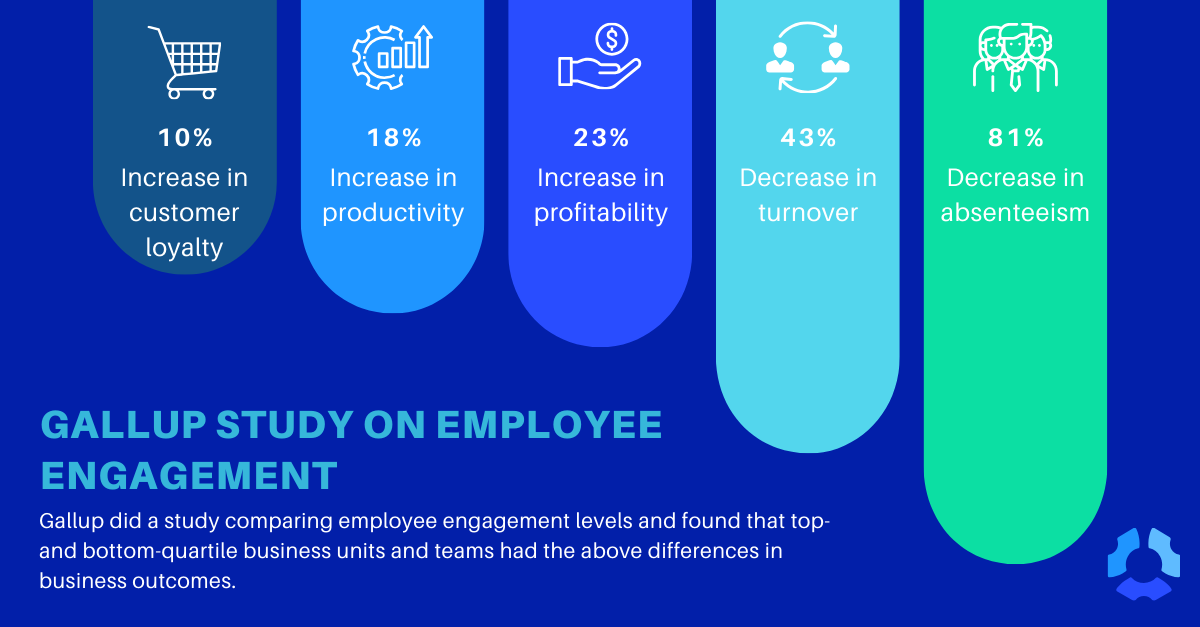
Gallup conducted a study comparing employee engagement levels and found that top-quartile teams and businesses faired significantly better than their lower-quartile counterparts in the following areas:
- 81% decrease in absenteeism
- 43% decrease in turnover
- 23% increase in profitability
- 18% increase in productivity
- 10% increase in customer loyalty
Finally, Gallup found that measuring employee engagement is the first step to increasing it. Let’s look at how leaders can do that.
How to quantify employee happiness and productivity
Employee satisfaction is not just a personal sentiment but a trigger that drives the workplace toward improved productivity, collaboration, and success.
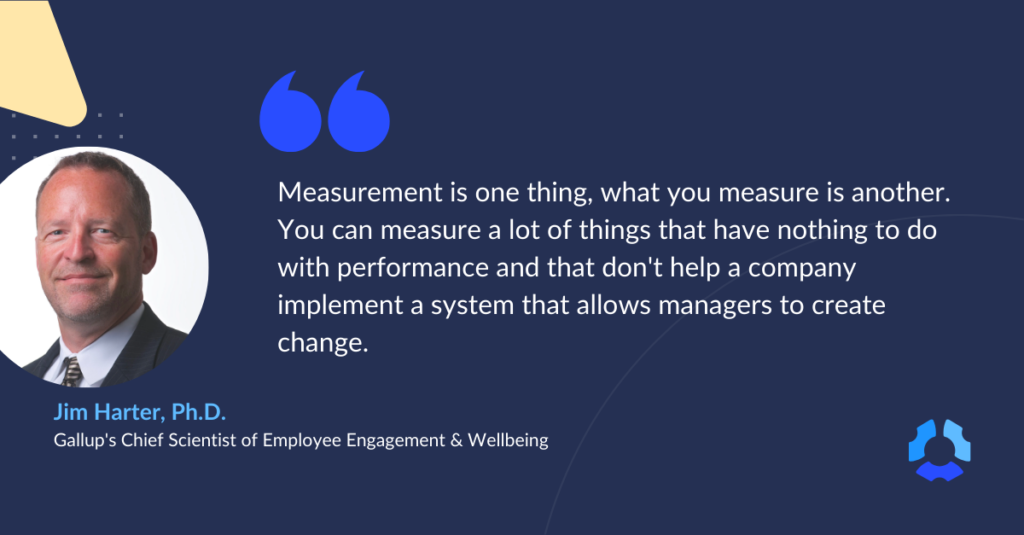
How can an evasive metric like “happiness” be tracked? Here are several strategies to measure and assess these factors:
- Conduct employee surveys: Conduct regular employee productivity surveys to gather feedback on job satisfaction, work-life balance, and overall happiness. Try to keep these surveys anonymous so employees feel comfortable sharing honest opinions.
- Track performance metrics: Utilize key performance indicators (KPIs) relevant to each role to measure productivity objectively. These could include project completion rates, sales targets, productivity rates, or other quantifiable output metrics.
- Monitor absenteeism and turnover rates: Track absenteeism and turnover rates, as higher levels may indicate dissatisfaction or burnout. Conversely, low rates might signify contentment and higher productivity.
- Employee happiness index: Develop an employee happiness index that combines various factors, including job satisfaction, work-life balance, and overall well-being. Regularly assess and update this index to gauge changes over time.
- Employee Assistance Programs (EAPs) Metrics: Assess the utilization and effectiveness of employee assistance programs. Increased usage may indicate higher stress levels and decreased satisfaction.
We’re big believers in optimizing your tech stack to reduce manual work, and tracking employee satisfaction is one thing that can be done automatically using the right software.
Tools and technologies to monitor and improve satisfaction
Leaders can leverage employee productivity tools and software to improve employee satisfaction. These tools can help them gauge task progress, improve time management, and incentivize collaboration across teams. Then, use these tools to analyze data and identify patterns related to productivity automatically.
Hubstaff
Hubstaff is a comprehensive workforce management tool that tracks time and activity. It also serves as a way to gauge employee satisfaction and productivity. With performance badges, Daily Stand-ups, and other EX features to prevent burnout, you can prioritize your team’s mental health without compromising productivity.
Hubstaff uses simple, intuitive time tracking to generate real-time updates and insights about the way you work. Every user can see their own data, while managers can see this information for their whole team. That means better visibility into employee work hours, payroll, productivity metrics, and more. This data helps leadership spot improvements and dips in employee productivity over time.
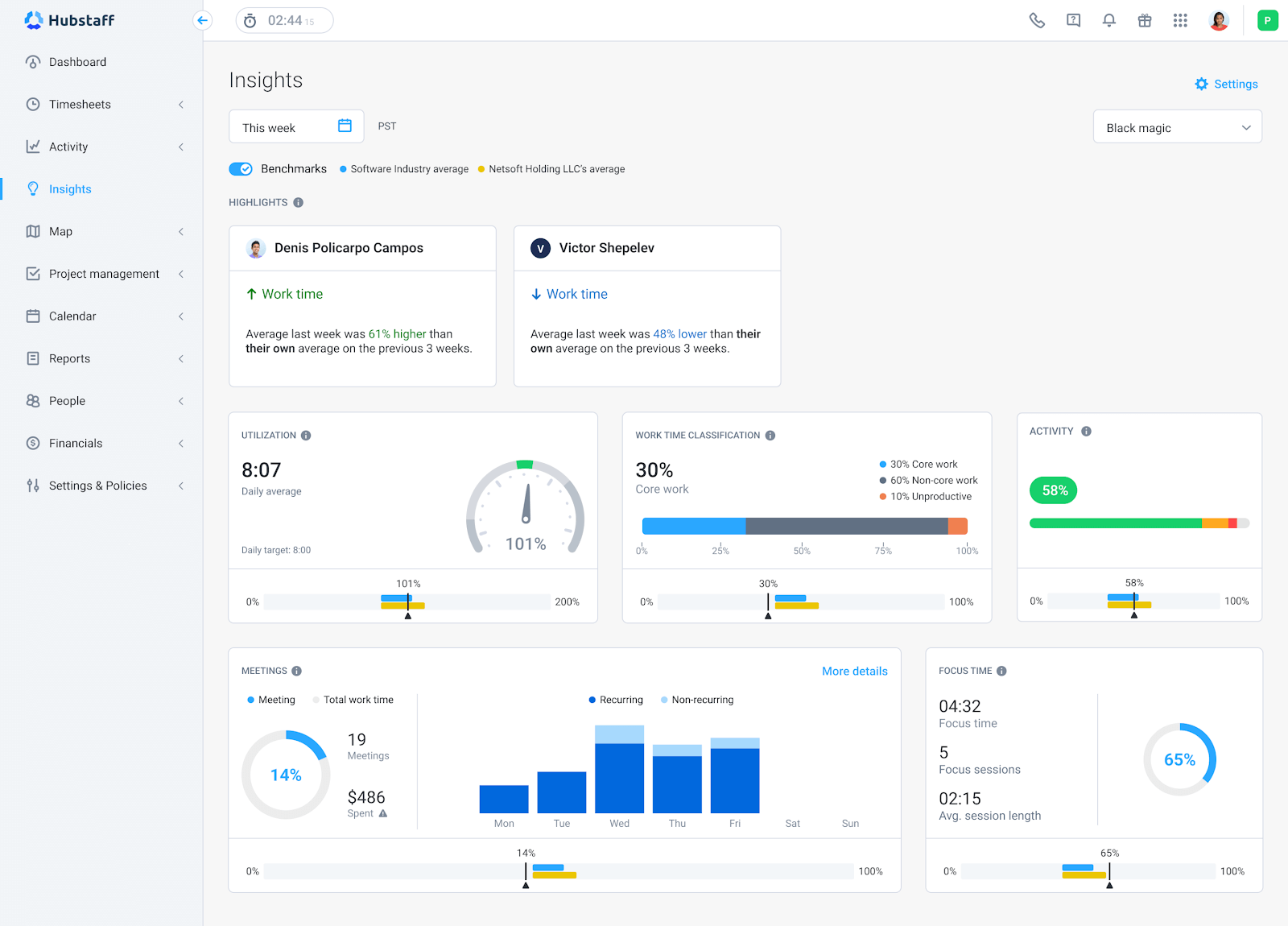
Looking for more in-depth data? Try Hubstaff Insights for a high-level breakdown of employee and team performance. With Insights, you can:
- Balance meeting and focus time
- See real-time utilization rates
- Sort productive and unproductive apps
- See real-time performance trends and updates with Highlights
SurveyMonkey
SurveyMonkey is a versatile survey platform that enables organizations to create and distribute customized employee satisfaction surveys. It provides valuable insights into employee sentiments and perceptions, helping organizations make informed decisions to enhance workplace satisfaction.
Glint
Glint is an employee engagement platform that offers surveys and analytics to measure employee satisfaction. It provides actionable insights to help organizations make informed decisions and enhance employee experience.
Finding the right productivity tool can help managers streamline workflows, enhance team collaboration, and optimize efficiency.
Strategies to enhance employee satisfaction
Once you find a way to quantify employee satisfaction, how do you improve your team’s satisfaction levels? Here are some essential methods you can employ today.
- Establish a positive work culture. Foster a positive workplace culture by promoting open communication, collaboration, and mutual respect. Create a supportive environment where employees feel valued, included, and motivated to contribute.
- Provide recognition and rewards. Implement recognition programs to acknowledge and reward employee achievements. Whether through public commendations, Slack shout-outs, or other incentives, recognizing hard work boosts morale.
- Invest in career development. Offer opportunities for skill development and career advancement. Providing training programs, workshops, and mentorship opportunities demonstrates a commitment to employee growth that contributes to greater job satisfaction.
- Promote work-life balance. Encourage a healthy work-life balance by implementing flexible work arrangements, time-off policies, and initiatives prioritizing employee well-being. Ensure team leaders demonstrate their work-life balance so employees know this is the norm.
- Focus on trust and transparency. Create transparent communication channels to inform employees about organizational goals, changes, and expectations. Regular updates, team meetings, and an open-door policy help build trust and foster a positive work environment.
Management sets the tone for creating a positive workplace culture that nurtures employee satisfaction and productivity. By prioritizing effective communication, recognizing contributions, fostering growth, and promoting a supportive work environment, you can lay the foundation for a high-performing, happy workforce.
Case studies: successful company employee engagement policies
Let’s take the idea of employee engagement strategies into the real world and take a page from the book of some of the world’s top companies.
Microsoft
According to TIME Magazine, Microsoft is the best company in the world right now, so they were our first choice for inspiration. They scored over 96 out of 100 in employee satisfaction, revenue growth, and sustainability in 2023.
Curious how they did it? Microsoft’s approach to fostering employee engagement involves several vital strategies:
- Professional development: Microsoft actively promotes a culture of professional growth. CEO Satya Nadella emphasizes a “learn-it-all” mindset, acknowledging employees who embody this philosophy through recognition videos.
- Employee insights: To gauge employee sentiment, Microsoft employs the ‘Daily Pulse,’ a series of pulse surveys that provide insights into the workforce’s feelings and engagement trends.
- Creating a community: Microsoft also strongly emphasizes team-building activities, organizing events that strengthen internal bonds and align with core company values, such as social responsibility through community outreach.
Intuit
94% of Intuit staff say it is a great place to work. So how do they do it? They focus on a few key strategies:
- DEI emphasis: Intuit consistently champions diversity and inclusion — and they establish the benchmarks to actually measure their progress. The company conducts various training sessions, including the Leading Inclusively e-learning course, to support its commitment to diversity and inclusion.
- Celebrating milestones: 95% of employees said the company celebrates special events. This emphasis on celebrating milestones creates a sense of camaraderie throughout the team.
- Pay equity: Acknowledging the importance of pay equity in fostering diversity and inclusion, Intuit emphasizes its role in enhancing employee engagement. The company views pay equity as fundamental to its diversity and inclusion strategy.
Final words: Happy employees are the key to business success
By now, it should be clear that a company’s success is driven by employee happiness, so a positive attitude goes a long way. It’s important to prioritize human resources management, employee training opportunities for advancement, and other incentives aimed at creating happy, productive teams. The long-term effects of employee satisfaction on performance include enhanced employee retention, a stable and experienced workforce, increased productivity, and improved overall organizational success.
As a manager, your ability to gauge employee satisfaction accurately will empower you to identify areas for improvement, foster a positive environment, and enhance team morale, contributing to increased productivity and employee retention.
Have any tips that helped you increase employee satisfaction, improve job satisfaction, manage unhappy employees, or improve your company’s culture?
Most popular
The Fundamentals of Employee Goal Setting
Employee goal setting is crucial for reaching broader business goals, but a lot of us struggle to know where to start. American...
Data-Driven Productivity with Hubstaff Insights: Webinar Recap
In our recent webinar, the product team provided a deep overview of the Hubstaff Insights add-on, a powerful productivity measurem...
The Critical Role of Employee Monitoring and Workplace Security
Why do we need employee monitoring and workplace security? Companies had to adapt fast when the world shifted to remote work...
15 Ways to Use AI in the Workforce
Whether through AI-powered project management, strategic planning, or simply automating simple admin work, we’ve seen a dramatic...


